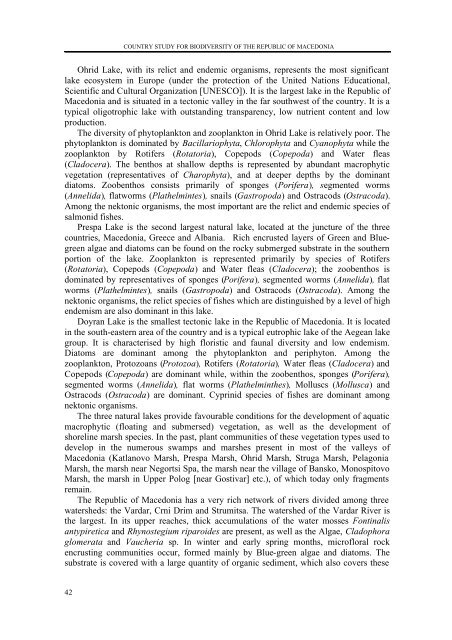English - Convention on Biological Diversity
English - Convention on Biological Diversity
English - Convention on Biological Diversity
Create successful ePaper yourself
Turn your PDF publications into a flip-book with our unique Google optimized e-Paper software.
42<br />
COUNTRY STUDY FOR BIODIVERSITY OF THE REPUBLIC OF MACEDONIA<br />
Ohrid Lake, with its relict and endemic organisms, represents the most significant<br />
lake ecosystem in Europe (under the protecti<strong>on</strong> of the United Nati<strong>on</strong>s Educati<strong>on</strong>al,<br />
Scientific and Cultural Organizati<strong>on</strong> [UNESCO]). It is the largest lake in the Republic of<br />
Maced<strong>on</strong>ia and is situated in a tect<strong>on</strong>ic valley in the far southwest of the country. It is a<br />
typical oligotrophic lake with outstanding transparency, low nutrient c<strong>on</strong>tent and low<br />
producti<strong>on</strong>.<br />
The diversity of phytoplankt<strong>on</strong> and zooplankt<strong>on</strong> in Ohrid Lake is relatively poor. The<br />
phytoplankt<strong>on</strong> is dominated by Bacillariophyta, Chlorophyta and Cyanophyta while the<br />
zooplankt<strong>on</strong> by Rotifers (Rotatoria), Copepods (Copepoda) and Water fleas<br />
(Cladocera). The benthos at shallow depths is represented by abundant macrophytic<br />
vegetati<strong>on</strong> (representatives of Charophyta), and at deeper depths by the dominant<br />
diatoms. Zoobenthos c<strong>on</strong>sists primarily of sp<strong>on</strong>ges (Porifera), segmented worms<br />
(Annelida), flatworms (Plathelmintes), snails (Gastropoda) and Ostracods (Ostracoda).<br />
Am<strong>on</strong>g the nekt<strong>on</strong>ic organisms, the most important are the relict and endemic species of<br />
salm<strong>on</strong>id fishes.<br />
Prespa Lake is the sec<strong>on</strong>d largest natural lake, located at the juncture of the three<br />
countries, Maced<strong>on</strong>ia, Greece and Albania. Rich encrusted layers of Green and Bluegreen<br />
algae and diatoms can be found <strong>on</strong> the rocky submerged substrate in the southern<br />
porti<strong>on</strong> of the lake. Zooplankt<strong>on</strong> is represented primarily by species of Rotifers<br />
(Rotatoria), Copepods (Copepoda) and Water fleas (Cladocera); the zoobenthos is<br />
dominated by representatives of sp<strong>on</strong>ges (Porifera), segmented worms (Annelida), flat<br />
worms (Plathelmintes), snails (Gastropoda) and Ostracods (Ostracoda). Am<strong>on</strong>g the<br />
nekt<strong>on</strong>ic organisms, the relict species of fishes which are distinguished by a level of high<br />
endemism are also dominant in this lake.<br />
Doyran Lake is the smallest tect<strong>on</strong>ic lake in the Republic of Maced<strong>on</strong>ia. It is located<br />
in the south-eastern area of the country and is a typical eutrophic lake of the Aegean lake<br />
group. It is characterised by high floristic and faunal diversity and low endemism.<br />
Diatoms are dominant am<strong>on</strong>g the phytoplankt<strong>on</strong> and periphyt<strong>on</strong>. Am<strong>on</strong>g the<br />
zooplankt<strong>on</strong>, Protozoans (Protozoa), Rotifers (Rotatoria), Water fleas (Cladocera) and<br />
Copepods (Copepoda) are dominant while, within the zoobenthos, sp<strong>on</strong>ges (Porifera),<br />
segmented worms (Annelida), flat worms (Plathelminthes), Molluscs (Mollusca) and<br />
Ostracods (Ostracoda) are dominant. Cyprinid species of fishes are dominant am<strong>on</strong>g<br />
nekt<strong>on</strong>ic organisms.<br />
The three natural lakes provide favourable c<strong>on</strong>diti<strong>on</strong>s for the development of aquatic<br />
macrophytic (floating and submersed) vegetati<strong>on</strong>, as well as the development of<br />
shoreline marsh species. In the past, plant communities of these vegetati<strong>on</strong> types used to<br />
develop in the numerous swamps and marshes present in most of the valleys of<br />
Maced<strong>on</strong>ia (Katlanovo Marsh, Prespa Marsh, Ohrid Marsh, Struga Marsh, Pelag<strong>on</strong>ia<br />
Marsh, the marsh near Negortsi Spa, the marsh near the village of Bansko, M<strong>on</strong>ospitovo<br />
Marsh, the marsh in Upper Polog [near Gostivar] etc.), of which today <strong>on</strong>ly fragments<br />
remain.<br />
The Republic of Maced<strong>on</strong>ia has a very rich network of rivers divided am<strong>on</strong>g three<br />
watersheds: the Vardar, Crni Drim and Strumitsa. The watershed of the Vardar River is<br />
the largest. In its upper reaches, thick accumulati<strong>on</strong>s of the water mosses F<strong>on</strong>tinalis<br />
antypiretica and Rhynostegium riparoides are present, as well as the Algae, Cladophora<br />
glomerata and Vaucheria sp. In winter and early spring m<strong>on</strong>ths, microfloral rock<br />
encrusting communities occur, formed mainly by Blue-green algae and diatoms. The<br />
substrate is covered with a large quantity of organic sediment, which also covers these
















